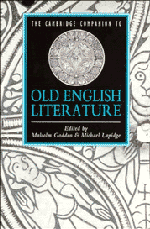Book contents
- Frontmatter
- 1 Anglo-Saxon society and its literature
- 2 The Old English language
- 3 The nature of Old English verse
- 4 The nature of Old English prose
- 5 Germanic legend in Old English literature
- 6 Heroic values and Christian ethics
- 7 Pagan survivals and popular belief
- 8 Beowulf
- 9 Fatalism and the millennium
- 10 Perceptions of transience
- 11 Perceptions of eternity
- 12 Biblical literature
- 13 Biblical literature
- 14 The saintly life in Anglo-Saxon England
- 15 The world of Anglo-Saxon learning
- Further reading
- Index
- Series List
14 - The saintly life in Anglo-Saxon England
Published online by Cambridge University Press: 28 May 2006
- Frontmatter
- 1 Anglo-Saxon society and its literature
- 2 The Old English language
- 3 The nature of Old English verse
- 4 The nature of Old English prose
- 5 Germanic legend in Old English literature
- 6 Heroic values and Christian ethics
- 7 Pagan survivals and popular belief
- 8 Beowulf
- 9 Fatalism and the millennium
- 10 Perceptions of transience
- 11 Perceptions of eternity
- 12 Biblical literature
- 13 Biblical literature
- 14 The saintly life in Anglo-Saxon England
- 15 The world of Anglo-Saxon learning
- Further reading
- Index
- Series List
Summary
If a modern English traveller could suddenly be transported back a thousand years into an Anglo-Saxon church, he would be astonished at the differences between that and the churches with which he is familiar today: here, the atmosphere inside most churches is one of calm and beatific silence; there, the prevailing atmosphere would be one of tumult and squalor, the church packed day and night with crowds of diseased and penitent persons seeking release from their sufferings through the intercession of the saint whose shrine they were besieging. A memorable picture of such tumult is given by Lantfred, a foreign monk at Winchester in the 970s, who, describing the miracles performed through the agency of St Swithun - then recently discovered and recently translated - shows us the inside of the Old Minster crammed with persons afflicted with appalling physical deformities, festering wounds, blind, paralytic, deaf, dumb, mutilated indescribably by the just process of the law or by self-imposed penitential torture, all clustered around the shrine of St Swithun, lying there day and night moaning in pain and praying aloud for deliverance from their suffering. On occasion, Lantfred reports, the church's precincts were so plugged with diseased persons that they had periodically to be cleared to make way for the clergy. Whereas today such appalling sights of disease, deformity and suffering are hidden from sight in sanitized hospitals, a thousand years ago they were on full view, every day of the year, in every church which had a saint deemed to be capable of performing a miraculous cure.
- Type
- Chapter
- Information
- The Cambridge Companion to Old English Literature , pp. 243 - 263Publisher: Cambridge University PressPrint publication year: 1991
- 6
- Cited by

